Kilobo Lore!
In this section you will find a history of the setting for this little drama, as well as the organisation and disposition of the loyal-to-the-Imperium regime that presently reigns. Obviously as it is a war game there will be somewhat of a focus on military aspects, but I tried to do more than just that. To the right is an index that will help you navigate this absurdly long piece! Whenever you want to get somewhere, use the floating right hand menu to take you to the section, then the within index menu to further specify. I think that means that despite the length any particular thing is never more than two clicks away.
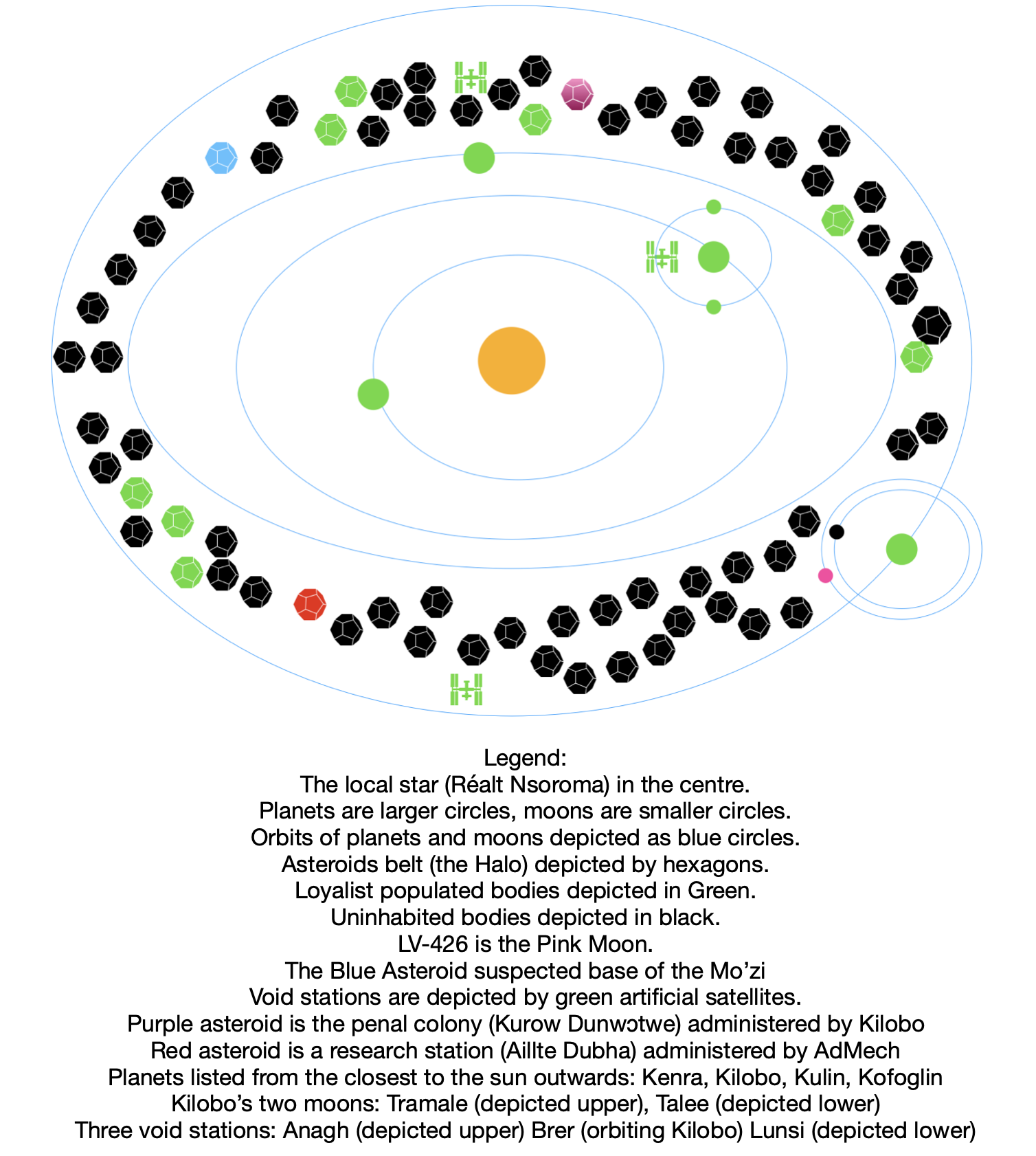
The Kilobo system is located in the Ultima Segmentum, nestled just off the galactic northwest of Ultramar and to the galactic southwest of the Tau Empire. And as is now known, it is just on the border of the Sautekh dynasty’s traditional domain. It was settled in humanity’s golden age, as the four planets orbiting its central star Réalt Nsoroma were all ripe for terraformation given the technology available at the time. Kilobo itself is the second planet from Réalt Nsoroma and by far the largest, a temperate planet with a climate not dissimilar in its variety and types from ancient Terra itself. This was established as the system capital and has remained so into the 41st millennium.
Each of the four planets in the system were developed to the point of being what would now be called self-sufficient civilised worlds. Kenra, the closest planet to Réalt Nsoroma, was probably intended to play something like the role of a pleasure planet, having a climate that can be described as idyllic, and fairly minimal industry. Events to transpire meant it no longer has anything like the role of a giant holiday resort, but the planet-wide quasi-Mediterranean climate remains. Kulin, the third planet from the sun and second largest after Kenra, tends towards a cold climate akin to something like Scandinavia of old Terra. It is the most industrialised of the planets, slightly poorer than Kilobo and never quite as well politically organised. Kofoglin on the other hand is the smallest of the planets, its surface being very largely covered by a humid rainforest, within which live a variety of sauropods. It is theorised these were brought in as domesticated aids to labour, but in the time since the golden age humanity lost control and they came to be a significant danger.
Both of Kilobo’s moons were terraformed, the smaller of them (Tramale) eventually being entirely covered by administrative and logistical infrastructure where the system’s governance, Imperial representation, bureaucracy, and emergency storage is all handled to this day. Tramale is a hive world, albeit more similar to Alecto than Necromunda — spread out and relatively flat rather than concentrated and spired. The larger (Dwadála) is naught more than a giant transit hub and garrison. Kofoglin has two moons, one of which had received just the early stages of terraforming - with a just-about breathable atmosphere - when some ancient disaster struck and ended the project for good. As it stands it is a wind blasted barren nightmare of a place to live, and only the research station with its attendant minor starport host any permanent inhabitants. The other remains uninhabitable. Finally the halo ring of asteroids (which unusually sits between the third and fourth planets -- it is theorised that Kofoglin was once just an unusually large member of the halo ring) contains a wealth of minerals that can be profitably mined and as such a number of them (along with two void-stations, which are commanded together from a military run void-station orbiting Kilobo) are inhabited by small work ports hosting small communities of permanent Halo dwellers and many itinerant workers.

From what can be told the system was prosperous and well governed during the golden age, but as with so many other places Kilobo system was to suffer hard during the age of strife. In particular, the rise of psychers following the opening of the Eye of Terror was to wreak havoc and lead to political instability whose consequences dogs the system to this day. The planets being self-sufficient, on political good terms, well resourced, and in easy range of sublight travel of one another, meant the system’s populace initially thought they were well placed to ride out the fracturing of humanity’s first stellar empire by the widespread warp storms. It was no doubt a shock to lose contact with the rest of the species out of sublight travel range, but it was not a matter of life and death. However, they had no way of preparing for the social upheaval that was to come from some of their number gaining psychic powers.
Immense psychic powers turned out to be concentrated in very few families. Quickly, on all four worlds, these psychers rose to power and mentally subjugated the population. What is more, using foul technomancy they found ways of projecting their power outwards to suppress independent thought in most of the population. This meant that they did not even need to be physically present to subjugate people, their power was projected out to reach every square foot of the inhabited zones of the planets. By treaty among themselves they divided up the various zones of each of the four planets and the habitable sub-planet bodies to ensure that as much of the population as possible was always to be covered by at least one psycher projecting this suppressant aura. Non-psychers were ever dimly aware of their situation, but unable to quite summon the will or concentration required to do anything about it. On those rare occasions wherein anyone did manage to avoid or break through from the widespread use of mind control and constantly projected propaganda most were subject to, this psychic aristocracy was quite willing to make use of good old fashioned brutality and terror tactics. For this end they maintained the Cadre; well armed and mentally-free sadists who for pay hunted down and brutalised any of their kin who gave signs of dissent.
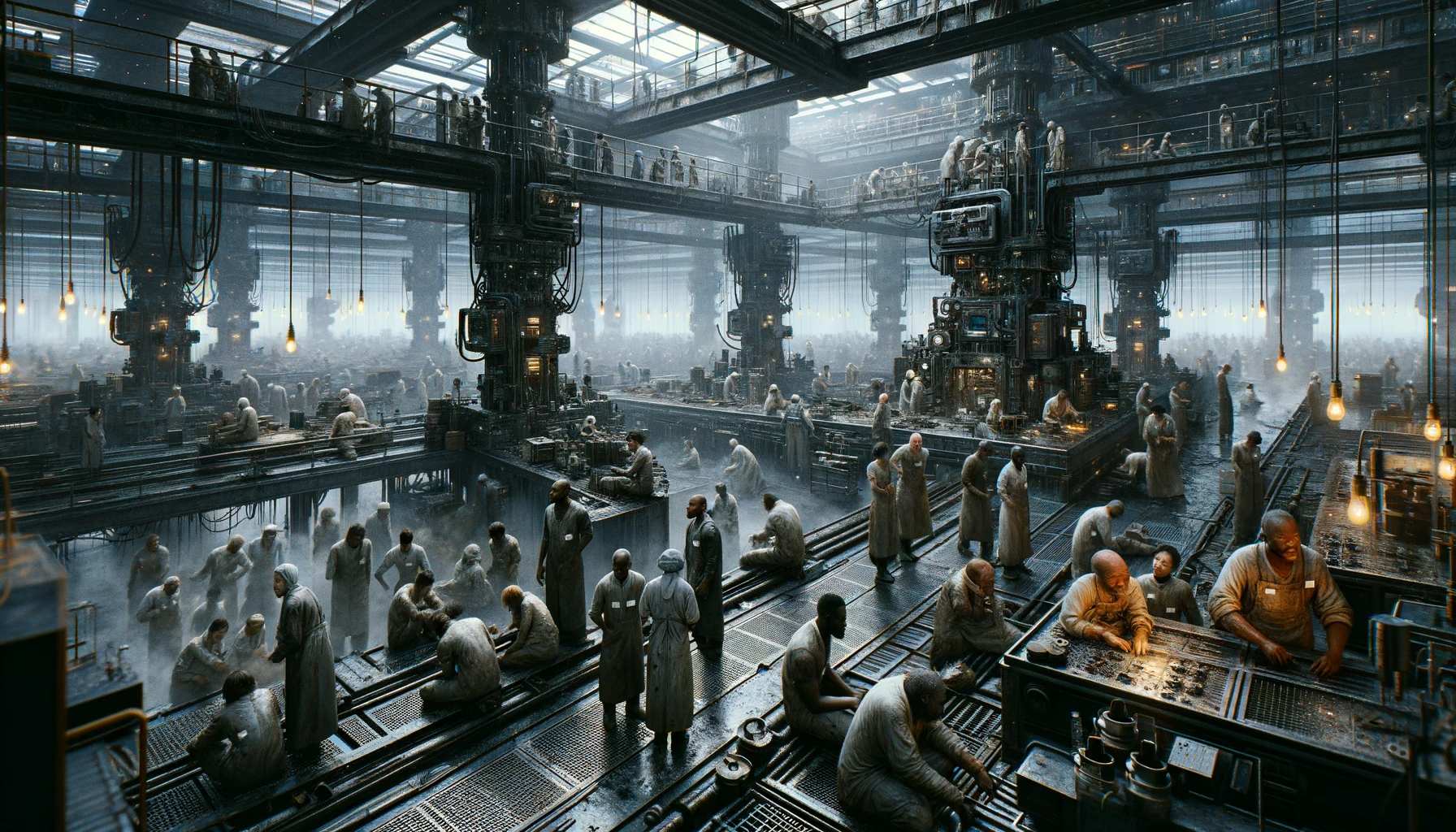
After centuries of this the ruling class becoming ever more cruel and sadistic with the human puppets they lauded over. The peculiar nature of the psychic domination they had achieved required no justifying ideology directed towards the masses. So far as they justified it to themselves they developed a theory of their own inherent superiority that legitimised their decadent lifestyles on those rare occasions their consciences stirred. Since they maintained more of the technology from the golden age than was typical of many human planets in Old Night, their standard of living was astonishing, and they lived long lives of wicked excess. It was probably at this point that the Prince of Pleasure took notice of this system and, while she did not act immediately, his interest being piqued could prove ruinous in the fullness of time.
More immediately, however, as Old Night's warp storms abated the relatively high technological development of the Kilobo system attracted the attention of a lone Martian explorator vessel. Not being interested in the living standard of the population (if anything being impressed that they so selflessly tended to their workstations and maintained their technology) the Martians entered into negotiations with the ruling psychic aristocracy. With promises of trade and mutual technological gain they had soon secured agreement to enter into the Martian protectorate from Kilobo’s ruling class. The vessel bearing news of this agreement was to head off into the warp back to Mars so as to arrange the transfer of materials and personnel to ensure Martian governance was felt in Kilobo. As it happened it emerged far later than expected, such is the warp. This (random?) delay was to prove hugely significant to the subsequent political development of the system.
For almost to the day of the explorator’s departure was born Osei Conghaile. He was a null. This was undetected (and indeed unconceived of) because people simply had no idea that was possible. While the Old Regime (as it is now called) had existed and reproduced itself throughout the system for centuries, the rate at which nulls are born is so rare that this was (so far as we know) the first ever born in the Kilobo system. Conghaile grew up somewhat confused by the behaviour of his fellows, but not knowing any better went along with what seemed normal. It was sheer luck that no psycher ever passed close enough to him in his youth to feel the oddness of his presence - though, of course, by this point the ruling class rarely deigned to move among the masses, relying on their technological means of projecting their aura into population centre backed up by the patrols of their mercenary Cadre. However, as he reached adulthood and saw the difference between the ruling class, their sadist mercenaries, and the population respectively, he came to understand the nature of the regime he lived under; and to hate and resent it for what it was doing to his kin.
Eventually Osei came to believe that he knew a means of causing short term undetectable malfunctions in the devices used to project the suppression aura into the manufactura where he worked. In fact it was likely just his standing near them that sufficed to disrupt their operation, but in any case it gave him the confidence to start organising in secret. Soon one of his confederates, a fellow worker Sinéad Asantewaa, found a genuine mechanical means of undetectedly disrupting the devices on a more permanent basis. Slowly but surely this news was spread in secret until within a few years there were enough organised manufactura on Kilobo to launch a mass strike.
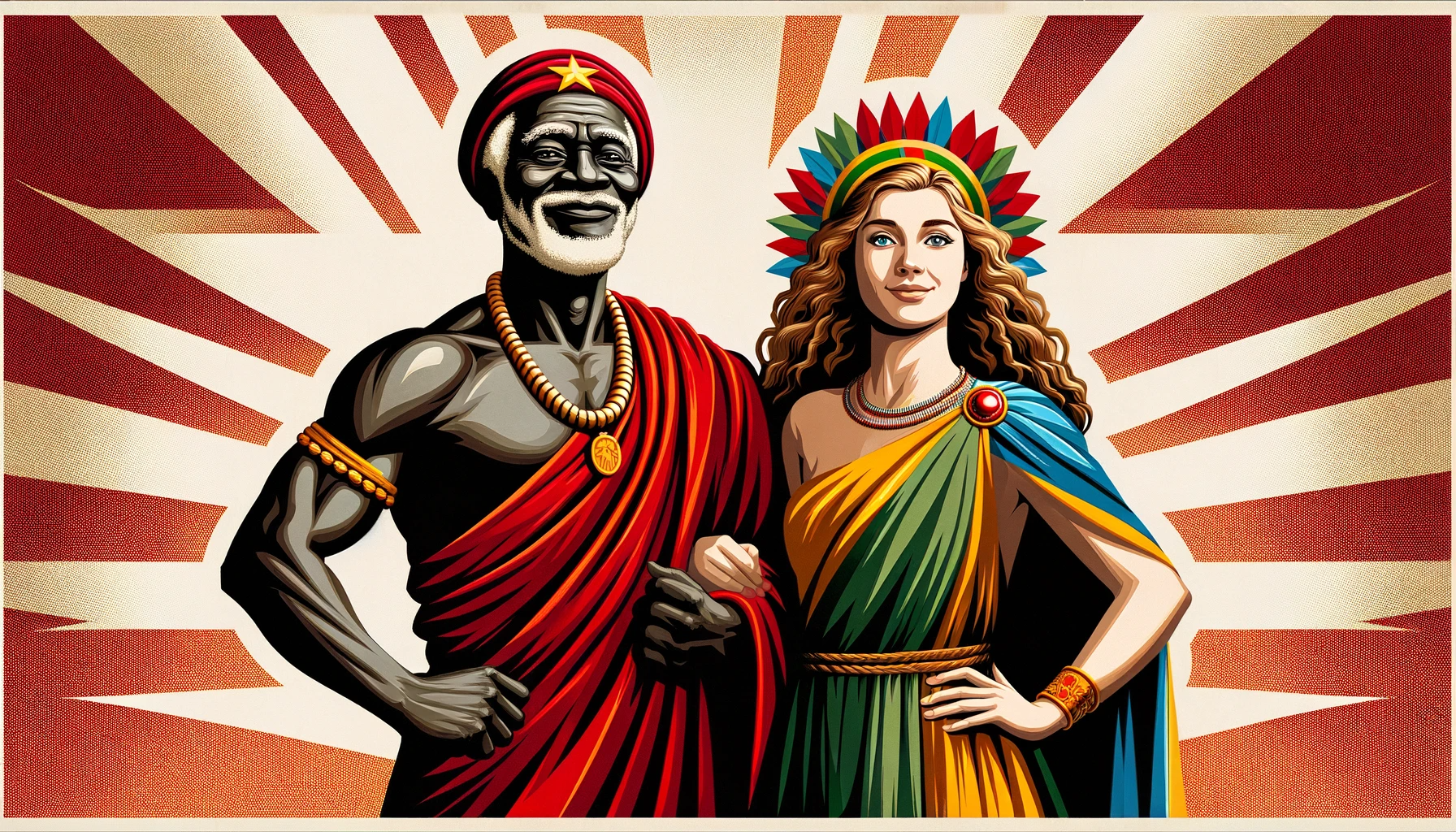
Conghaile's null status came to be attributed to the Emperor's
divine intervention, meaning the two are now reveared as saints.
The scale of the uprising shocked the aristocracy when it occurred, and the Cadre were rapidly overwhelmed. They were unused to dealing with large scale and well organised resistance, after all. In fact their very presence was to prove the downfall of the regime. Precisely because mental freedom was part of their payment for acting as regime thugs, their armouries and (most importantly) voidships were not equipped to project the psychic suppression aura. But this meant that as they melted away and their equipment was seized the rebels now had the means and ordinance to strike across the system, and to spread their revolutionary movement to every population centre.
While the fighting was hard, Osei and Sinéad’s rebellion was able to make fairly short work of the old regime once the void ports were secured. The aristocracy had simply grown arrogant, had no basis of popular support beyond mercenaries - and often they would immediately surrender rather than fight. What’s more their desperate calls for aid were lost in the void, since (unbeknownst to them) the Martian vessel bearing news of their fealty had not yet reached its destination, so no one was listening for messages from this system on any Mechanicus forgeworld.
Across the Kilobo system the psycher aristocracy were slaughtered en masse, the only ones left remaining being children from their families who had not reached an age at which they could display any latent psychic powers. While some counselled murdering even them, at Osei and Sinéad’s joint intervention this was felt to be the sort of act of cruelty characterisic of the regime they were rejecting. As such they were taken to a large habitable but sparsely populated planetoid in the halo ring, Kurow Dunwɔtwe, wherein they were to be monitored as they grew up. If they showed any signs of developing the sort of powers and tendencies of their parents they were to be executed, but if not they could live in peace there — albeit under a watchful eye of a military police answerable only to Kilobo. This was probably intended as a temporary measure and an act of mercy, however it was to devolve into a cruel and permanent occupation of a subjugated people.
The rest of the system underwent drastic reorganisation. The basic political unit across Kilobo became the manufactura or collective farm. These had been the basis of rebellion as they were the only place where Osei had been able to interact with many others without drawing suspicion. Under the old regime hab units had been strictly divided into individual blocks and no other civic life was provided or even permitted for the majority of the population. As such not only were the manufactura and collective farms trained to making decisions through the revolution, but in fact their very status as communal and collective was felt to be a joyous reprieve from what had gone before. Each manufactura or collective form elects both a head and a regional representative, each regional body elects a representative to be sent to the planetary body, and each planetary body sending a number of representatives to Kilobo (later and nowadays: Tramale) to represent them in system wide governance.
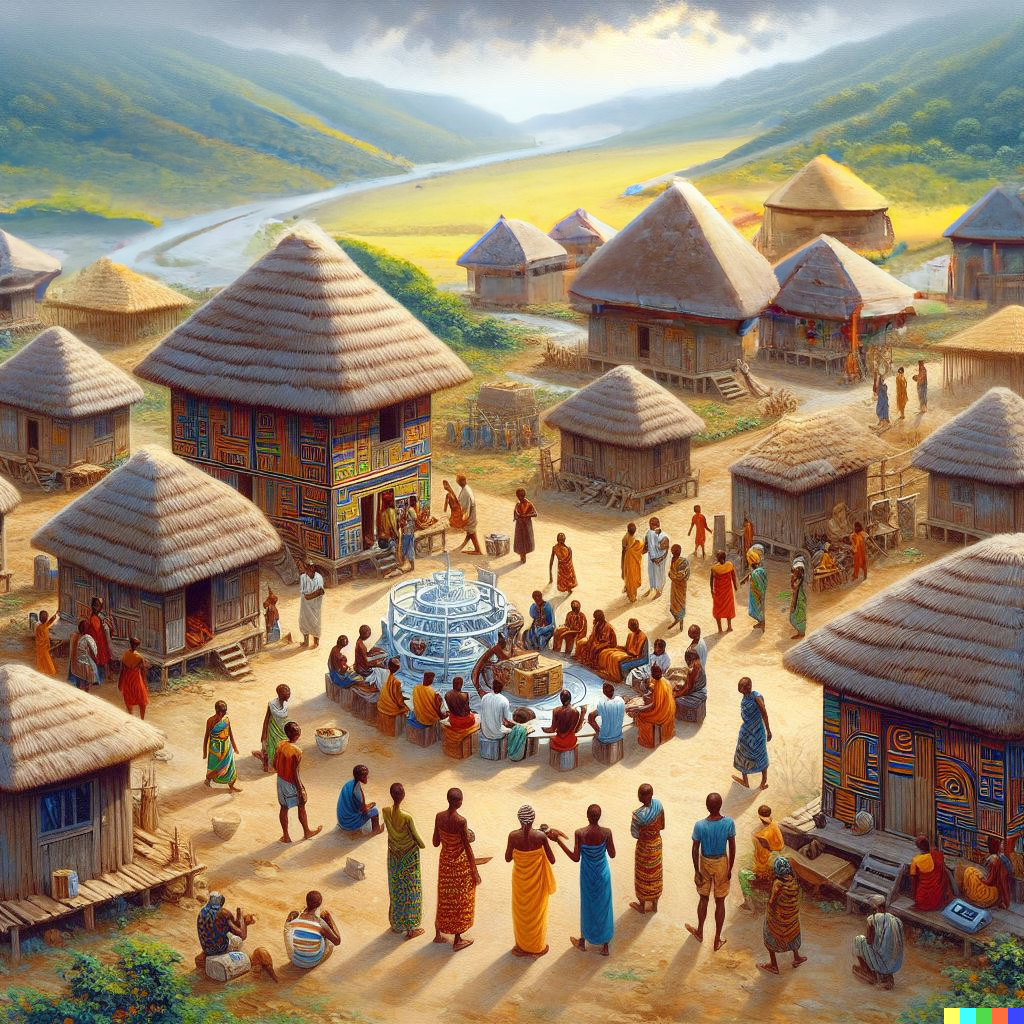
a prototype is being developed
in the communal area
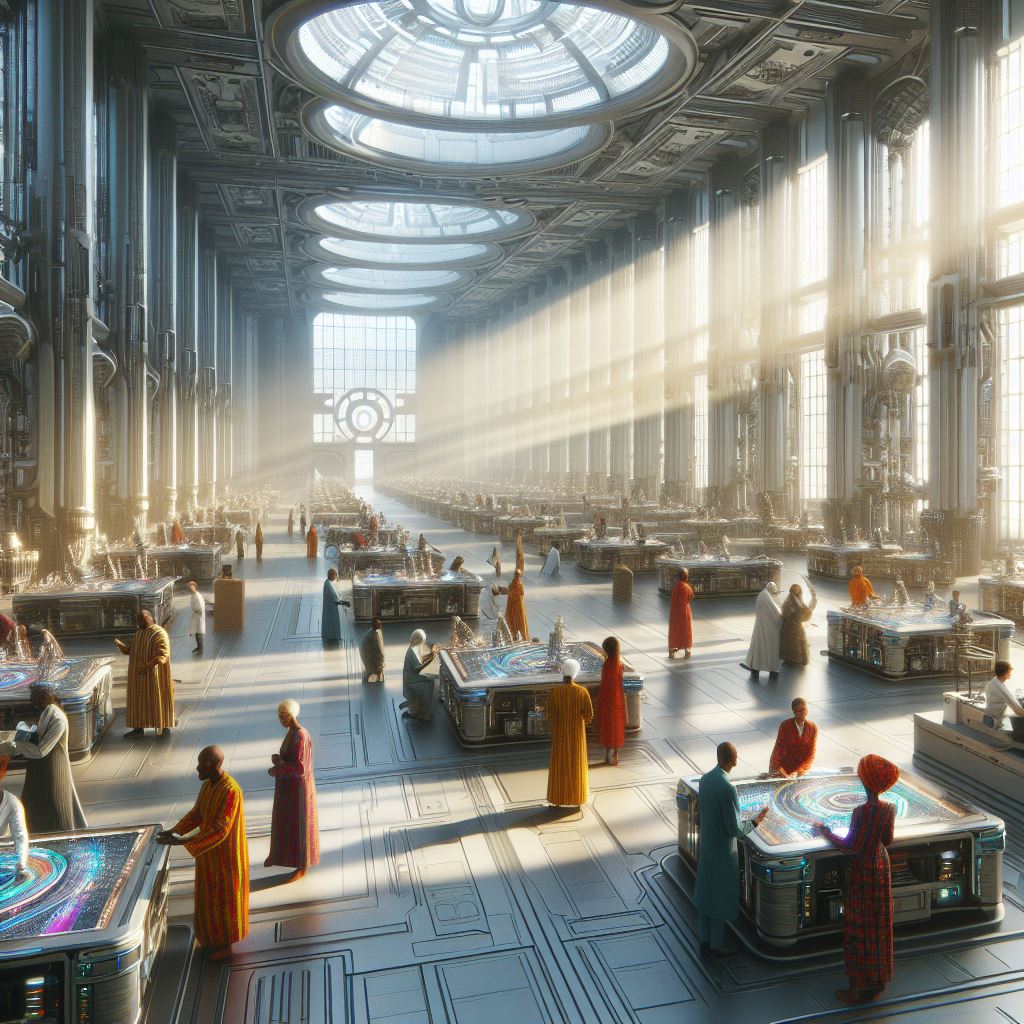
The output of their work was just as much changed as its character. The old aristocracy were seen as marked by their decadence, and in a rebellion against this at first ostentatious displays of wealth and luxury were strongly discouraged. Rather than producing luxury goods Conghaile-Asantewaa thought (as the philosophy governing this new way of life came to be known) encouraged production to satisfy necessities and beyond that ensure maximal leisure time available for all. As such the main output of industry were devices to be used in automating the tasks necessary for social reproduction - growing and harvesting foods, cleansing living spaces and filtering water, so and and so forth. These were then distributed among the communal living blocks and people encouraged to devote their now much freer time to personal betterment, arts, sport, and philosophy.
This new attitude was of course reflected in how people spend their time outside of work. Simple pleasures and communally shared good cheer were encouraged as, again, nearly the opposite of what they had been allowed previously. But anything too showy or which set one above another was seen as suspiciously reminiscent of those who had once oppressed them. This was to prove a weakness that fatally undermined Osei and Sinéad’s ideals. For in time this philosophy of humble striving for personal betterness was to degrade into a petty puritanical aversion to good living. Nowadays even outside of Kurow Dunwɔtwe the sytem of Kilobo embodies the contradiction of generating vast wealth through its trade and industry, yet its people live in dour communal dwellings and enjoy very few consumption goods. Just as before, amidst wealth they live in poverty - except now this poverty is enforced by the self-imposed bonds of ideology. Where Conghaile-Asantewaa had sought to minimise work for the sakes of time devoted to that which brought joy, joy itself came to be seen as suspicious and disreputable. Fortunately the Imperial creed would soon rescue the people from the lackadaisical idleness this might produce. For it was in this condition that a missionary fleet from Ultramar found the Kilobo system.
The missionary leading this expedition - Ikkyu Xavier - was incredibly well suited to this population. He preached a version of the Emperor’s creed which stressed abhorrence of the witch, the dignity of labour in service to the Emperor, and the common good of a humanity united. Quickly identifying the witch with the psychic aristocracy who had so recently lauded over them, the people of Kilobo were easy converts. What is more, coming as he did from Ultramar, he was disposed to himself be impressed by an efficiently organised production process and a disciplined population. It was a match made on Terra, and to this day people give thanks to the Emperor that so perfect a preacher was sent their way. Votive statues of Ikkyu Xavier still adorn many hab-commune collective spaces.
Since Kilobo’s new government felt in no way bound by treaties signed by the old regime, and were unaware that the Imperium that Xavier spoke of was in fact allied with the Martian regime they associated with their oppressors, they happily invited Ecclesiarchal representatives to open churches on their worlds, pledged allegiance to the Emperor, and opened up (profitable to this day) trading relationships with the planets of Ultramar. The quality of workmanship in machine parts the Kilobo system planets produced was quickly recognised, and their tithe was set in terms of large quantities of these specialised goods - especially what-we-would-call computer chips enabling far more powerful cogitation devices than the Imperium standard, facilitating advanced weaponry and labour saving devices most of the Imperium can only dream of. Since they were not in fact using much for consumption goods anyway the tithe had relatively little effect on standards of living within the system. In fact, due to the nature of their entrance into the Imperium the Church gets the lion’s share of the tithe and the system has to this day a special relationship with the Ecclesiarchy, protecting it from the sort of randomly imposed occasional excess tithing a lot of Imperium planets are subject to in exchange for this favoured access. Thus did Kilobo join the Imperium of Man.

walking to attend Temple
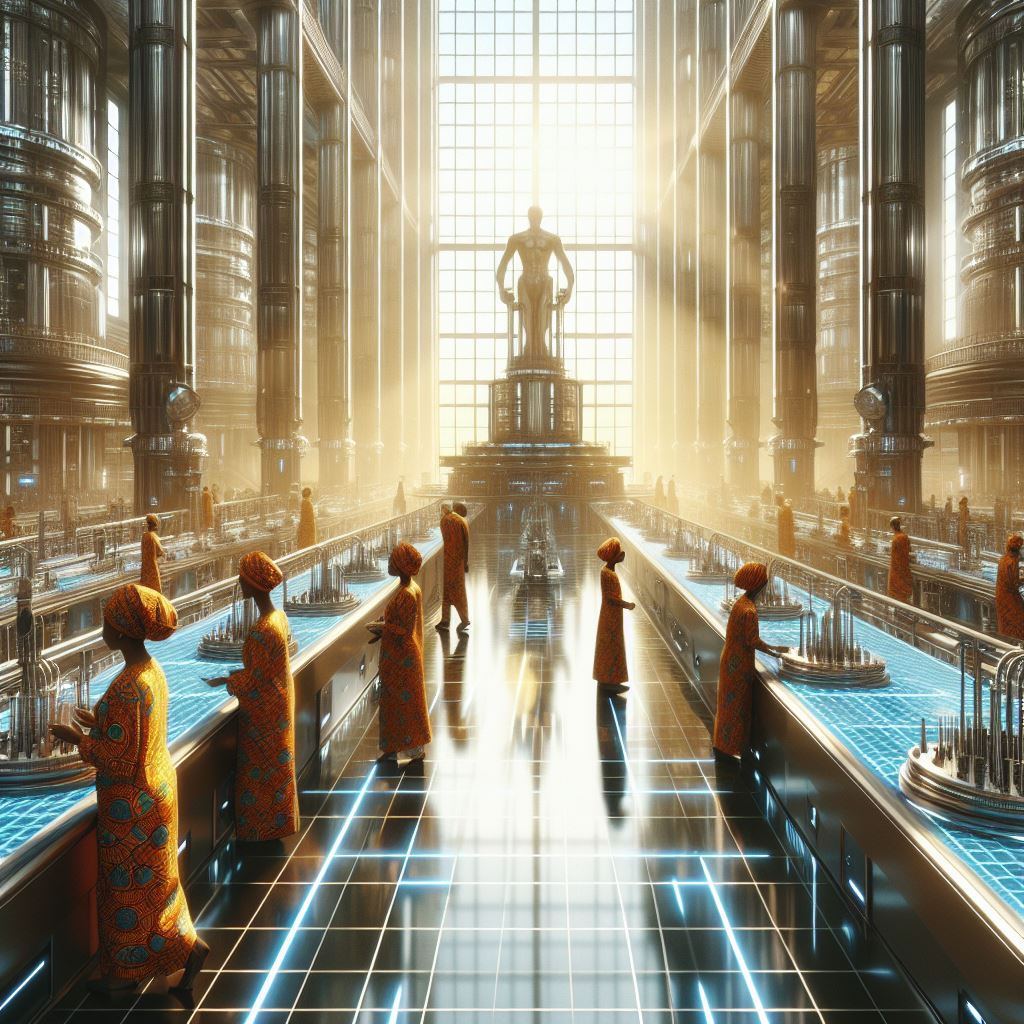
to mankind's Emperor was holy, and so newer
manufactora are designed to resemble Cathedrals.
Xavier was far too canny to lose a system-wide conversion over something so minor as this and so the use of servitors was easy to deemphasise or restrict to places out of public view. But none the less the risk of thinking machines could not be so placidly tolerated and if they were not to be replaced by servitors something would have to give. What then to do?
A solution was reached by a young worker in one of Kulin’s manufactura theological study groups. The young woman Ɔdɔlása developed a test for genuine creativity in devices. All those devices whose operation could be shown to be simply the result of electrical signals passed along in line with initial instructions from human operators — even if instructions carried out very quickly and subject to an unusual degree of competence — were at no risk of requiring the oversight of an abominable intelligence. This was analogous to a system of pulls and levers that had been miniaturised, after all, and no one thought winches blasphemous. Most devices used for labour saving in Kilobo in fact fell into this category and so could continue on unperturbed. Whereas those few machines which passed the test of genuine creativity were to be destroyed, and in whatever tasks they performed were to be replaced with (potentially vast) teams of fully human cogitators organised so as to collectively reproduce the results of that machine until a mechanical solution without the risk of blasphemy is found. Ikkyu found her solution most elegant, and to this day Our Lady Ɔdɔlása is revered on Kilobo as the saint of mechanised labour.

This goes especially in the vast Cogitation Halls of Kulin where her theological treatise provided work to people who had been at risk of structural unemployment if Kilobian technological production had been banned and replaced with servitors. The task of the Cogitation Halls became one of trying to work out how to reduce tasks that had required creativity to simple steps which could then be automated without incurring blasphemy, in line with Ɔdɔlása’s treatise. (They are thus something like universities dedicated entirely to constructive logic, programming, and electrical engineering -- but with a strong aversion to complex neural nets or other such blackbox methods. Anyother other than GOFAI is blasphemy!) Not only does this provide employment and ensure that Kilobo’s production methods are kept efficient, the early generation also saw it as a boon that it could lead to gradual decrease in the need for servitor use. As mentioned this is no longer considered such an important goal (though lip service to it is sometimes paid), but it has the consequence that servitor devices, while still common, are somewhat rarer in Kilobo than elsewhere in the Imperium. Of course many in the Mechanicus (at least of those appraised of the situation in this backwater sector) feel passionately that consistency with Ɔdɔlása’s treatise does not entail there is no tech heresy, so Kulin’s Cogitation Halls are seen as sites of blasphemy-apologetics by those most fanatically loyal to the Martian cult.

Having established Imperial compliance and an ecclesiarcal presence to his satisfaction, Xavier and his missionary fleet moved on. (He would eventually return to retire and die on Kenra, where he is still buried and receives pilgrims, revered as the patron saint of the system.) But in time the Mechanicus did return with a fleet to establish their presence in Kilobo. This caused a panic in the Kilobo governance, they marshalled their planetary defence forces and called on Imperium forces in Ultramar for aid in their defence. They received a rather confused reply from Ultramar - defence against Mars? Our allies? - and this was the occasion for all parties to realise the diplomatic quandary they were in fact ensconced in. What was to follow were rounds of diplomacy, cloak and dagger shenanigans, bribes and threats, and all manner of underhanded deeds, as Kilobo was poised between Imperial compliance vs direct Martian rule.
As it stands, possession being 9/10ths of intergalactic law, the sheer fact the Imperium was already present and tithing the region meant the Martians never really stood a chance. However, since the Kilobo system seemed to work with a lot of apparently valuable archeotech the Martians could not simply let it go. All the more so since they were rather less impressed by the reasoning of Our Lady Ɔdɔlása and felt the system was at risk of tech-heresy (and, worse, not such that they controlled). So an agreement was reached wherein the Martians would receive whatever samples of archeotech from Kilobo they requested, could request checks for tech heresy be carried out by their agents, and could maintain a permanent and autonomously governed research station on one of the larger bodies in the Halo - Aillte Dubha - to study technology provided. While not ideal from the Martian’s point of view, in the end access to the archeotech was the primary reason they cared about Kilobo so the deal was accepted.
On the other hand a Martian military and diplomatic presence - what is more an area of autonomous Martian governance, and ability to police and enforce their access to Kilobiean technology as they saw fit - in their system was, and still is, deeply resented by Kilobo’s habblocks who had not forgiven the Martians for allying with their old oppressors. But while the Ecclesiarchy was powerful and concerned with maintaining their favourable tithe enough to provide some protection, in the end Terra and Mars’ mutual need to maintain good relations was far more important than keeping the locals happy, and the deal was imposed on them without any serious ability on their part to object.
(Constant Martian surveillance also led to a rather odd social quandry for the Kilobians. While their technological base was clearly drawn from ancient human workings and so sanctioned, indeed sanctified, a planet full of artisans with only nominal commitment to Mechanicus doctrine might reasonably be expected to have regular economic growth. They in fact do commit tech heresy by way of innovation all the time, after all, and do so with the aim of securing efficiency gains. But with the Mechanicus looking over their shoulder clear evidence of such growth would be picked up on and used as evidence of heretical technological innovation. Especially since (much like a Van Saar) the typical Kilobian artisan knows altogether far more than a non-adept ought to know about the operation of technology and is by default therefore suspicious. The "solution" to this conundrum, of course never publicly acknowledged by officials on Tramale but more or less a system wide open secret, has been for a large share of the excess produce of any growth through innovation to be donated on top of their tithe "spontaneously" to the Ecclesiarchy as an act of piety, with only a little excess used for trade, investment, or consumption. So while living standards do rise over time they do so very slowly and never such to justify a dununciation in that very moment. And what's more they do so in a way that is always to the much larger benefit of their very powerful benefactor. To get the vibe imagine a Kilobian diplomat telling the Mechanicus representative "What, us, tech-heretics? Not at all! We just work harder every year inspired by our faith, and the Emperor blesses us with mysteriously improved washing machines! Surely you wouldn't wish to stand in the way of the omnissiah's blessings?" With a Terran Bishop and his extremely well armed entourage standing just behind pointedly nodding along.)
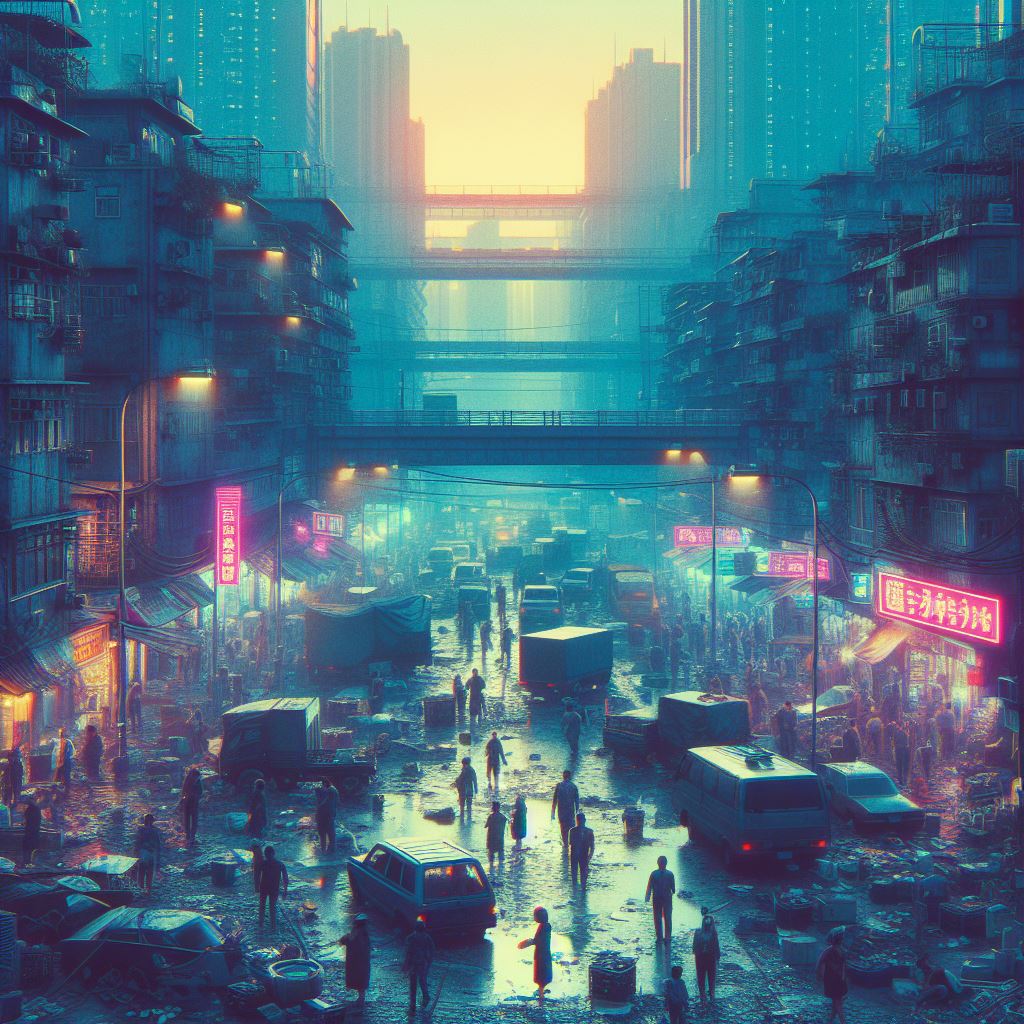
Kurow Dunwɔtwe thus appears to many as just a wretched hive of scum and villainy. The only problem the people in the rest of Kilobo really consider is how better to police them. Of course the planet evinces all the problems of poverty one would find anywhere else, but the contrast this makes with the rest of the system plus the general contempt they are held in means this only serves to justify their treatment in the eyes of the broader populace. When the black ships do occasionally visit the system it is inevitably on Kurow Dunwɔtwe they make collections, further reinforcing the population’s association with villainy in the eyes of most of the system. A sort of blood guilt has thus been laid upon the great great great great grand children of the oppressors, and in turn their ancestors for generations down, and the regime of Kilobiean military police occupying Kurow Dunwɔtwe exhibits none of the democratic features it does elsewhere.